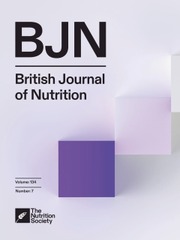Dear Editor,
I am writing in response to the recent publication by Nanri et al., titled ‘Meat Intake and Type 2 Diabetes among Japanese Workers: A Prospective Study’ (PMID: 39308209)(Reference Nanri, Irie and Kochi1), published online in the British Journal of Nutrition on 23 September 2024. The authors found no significant association between total meat, red meat or processed meat intake and the risk of type 2 diabetes (T2D) in a cohort of Japanese workers. Their findings contribute to a nuanced understanding of how dietary factors, particularly meat consumption, influence T2D risk across different populations. I would like to offer some reflections on this article based on a comprehensive review of the literature.
Insights from global studies
The findings of Nanri et al. diverge from much of the existing literature, which has consistently demonstrated a positive association between red and processed meat consumption and T2D risk. A large cohort study from the Harvard T.H. Chan School of Public Health found that the percentage lower risk of T2D associated with substituting 1 serving/d of nuts and legumes for total red meat was 30 % (HR = 0·70; 95 % CI 0·66, 0·74), for processed red meat was 41 % (HR = 0·59; 95 % CI 0·55, 0·64) and for unprocessed red meat was 29 % (HR = 0·71; 95 % CI 0·67, 0·75). Substituting 1 serving/d of dairy products for total, processed or unprocessed red meat was also associated with a significantly lower risk of T2D(Reference Gu, Drouin-Chartier and Sacks2). In an individual-participant federated meta-analysis involving data from 31 cohorts and 1·97 million adults with 100 000 incident cases, the cohorts were from the region of the Americas (n 12) and the Eastern Mediterranean (n 2), European (n 9), South-East Asia (n 1) and Western Pacific (n 7) regions. Greater consumption of each of the three types of meat (unprocessed red meat, 0–49 g/d for processed meat and 0–72 g/d for poultry) was associated with increased incidence of T2D, with HR of 1·10 (95 % CI 1·06, 1·15) per 100 g/d of unprocessed red meat (I 2 = 61 %), 1·15 (1·11, 1·20) per 50 g/d of processed meat (I 2 = 59 %) and 1·08 (1·02, 1·14) per 100 g/d of poultry (I 2 = 68 %)(Reference Li, Bishop and Imamura3).
It is also worth noting that the study by Nanri et al. had a relatively small sample size (2709 participants) and a modest number of T2D cases (135), which may have limited the statistical power to detect significant associations. Larger cohort studies or meta-analyses specific to Asian populations might provide more conclusive evidence.
Methodological considerations and regional dietary patterns
Nanri et al.’s study focuses on a Japanese population, where traditional dietary patterns differ markedly from those in Western countries. The lack of a significant association between meat consumption and T2D in this cohort may reflect the relatively low baseline consumption of red meat in Japanese diets, as well as the high intake of fish and plant-based foods such as soya compared with Western populations. High intake of fish and plant-based food might mitigate some of the negative metabolic effects observed with high red meat consumption in Western diets. Additionally, the study population’s baseline health status, lifestyle factors such as physical activity and genetic predispositions could also play a role in influencing the outcomes.
A systematic review on red meat and T2D risk noted that dietary context and population-specific factors, such as genetic predispositions and overall lifestyle, can substantially influence study outcomes(Reference Derbyshire and Ruxton4).
A prospective study on French women similarly highlighted that processed red meat, but not unprocessed red meat, was associated with incident T2D, further suggesting that the specific type of meat consumed and its preparation method may be important risk modifiers(Reference Lajous, Tondeur and Fagherazzi5).
Substitution effects and preventive strategies
While Nanri et al. did not find a significant association between meat consumption and T2D risk, evidence from other regions suggests that substituting red and processed meat with plant-based proteins can reduce T2D risk. A study from the European Prospective Investigation into Cancer and Nutrition (EPIC) project reported that replacing red meat with foods like nuts, legumes or dairy products could prevent up to 8·8 % of new diabetes cases(Reference Ibsen, Steur and Imamura6). These findings underscore the potential benefits of dietary interventions that prioritise plant-based foods, which is a strategy that could be explored further in Asian populations.
Conclusion
In conclusion, while Nanri et al.’s findings provide valuable insights into the relationship between meat consumption and T2D risk in Japan, they should be interpreted in light of the broader global literature. The contrasting results underscore the importance of population-specific research and suggest that the impact of red and processed meat on metabolic health may vary by region due to differing dietary patterns and cultural factors. I encourage further studies to investigate the potential role of meat type, preparation methods and dietary substitutions in mitigating T2D risk, particularly in non-Western settings.
Thank you for the opportunity to respond to this article. We believe this discussion will help to enrich the dialogue surrounding diet and diabetes prevention across diverse populations.
Acknowledgements
I confirm that there are no conflicts of interest for the authors.
Additionally, there are no financial or non-financial supports to declare.



